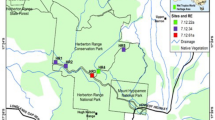Abstract
Kilimanjaro, a world heritage site and an icon of global change, not only suffers from climatic alterations but also is undergoing a drastic socio-economic upheaval. A strong increase of tourism enhances the risk of introducing alien plant species in particular in the upper zones of Kilimanjaro. One such species is Poa annua L., a cosmopolitan weed of European origin on roadsides and pastures. The aim of this study is to document its distribution, the speed of its propagation and risks for the indigenous vegetation of Kilimanjaro, and to compare the findings with other introduced species on this mountain. Based on a complete survey of the vegetation of Kilimanjaro with about 1,500 vegetation plots, plant communities invaded by Poa annua are determined. As with most of the other neophytes on Kilimanjaro, Poa annua invades only anthropogenic vegetation but not undisturbed natural vegetation. Similar to the situation in middle Europe, this neophyte is on Kilimanjaro a constituent of the vegetation of trampled ground, occurring between about 1,600 and 4,000 m asl along climbing routes or their vicinity. On a newly opened climbing route a rapid invasion (5.6 km in 3 months) was observed, which makes it likely that Poa annua spread on Kilimanjaro during the last 30 years in parallel to the increase of the climbing tourism. Although Poa annua is still in the stage of propagation, an invasion of natural vegetation types seems to be unlikely.



Similar content being viewed by others
References
Agnew ADQ, Agnew S (1994) Upland kenya wildflowers. East Africa Natural History Society, Nairobi
Beentje HJ (1994) Kenya trees, shrubs and lianas. National Museums of Kenya, Nairobi
Braun-Blanquet J (1964) Pflanzensoziologie. Springer, Wien
Clayton WD (1970) Gramineae Part 1. In: Milne-Redhead E, Polhill RM (eds) Flora of Tropical East Africa. Royal Botanic Gardens, Kew
D’Antonio CM, Kark S (2002) Impacts and extent of biotic invasions in terrestrial ecosystems. Trends Ecol Evol 17:202–204
Ellenberg H (1991) Zeigerwerte von Pflanzen in Mitteleuropa. Scripta Geobot 18:1–248
FTEA (1952–2005) Flora of Tropical East Africa. Royal Botanic Gardens, Kew
Hedberg O (1957) Afroalpine vascular plants. A taxonomic revision. Symb Bot Ups 15:1–411
Hedberg O (1964) Features of afroalpine plant ecology. Acta Phytogeogr Suec 49:1–144
Hedberg O (1970) Evolution of the Afroalpine flora. Biotropica 2(1):16–23
Hemp A (2001) Ecology of the pteridophytes on the southern slopes of Mt. Kilimanjaro. Part II: habitat selection. Plant Biol 3:493–523
Hemp A (2005) Climate change driven forest fires marginalizes the ice cap wasting on Mt. Kilimanjaro. Global Change Biol 11:1013–1023
Hemp A (2006a) Continuum or zonation? Altitudinal diversity patterns in the forests on Mt. Kilimanjaro. Plant Ecol 184(1):27–42
Hemp A (2006b) The banana forests of Kilimanjaro. Biodiversity and conservation of the agroforestry system of the Chagga Home Gardens. Biodivers Conserv 15:1193–1217
Hemp A (2006c) Vegetation of Kilimanjaro: hidden endemics and missing bamboo. Afr J Ecol 44:305–328
Hemp A (2006d) Ecology and altitudinal zonation of pteridophytes on Mt. Kilimanjaro. In: Proceedings of the XVIIth AETFAT Congress, 21–26 September 2003
Hemp C, Hemp A (2003) Saltatoria coenoses of high-altitude grasslands on Mt. Kilimanjaro, Tanzania (Orthoptera: Saltatoria). Ecotropica 9:71–97
Hemp A, Lambrechts C, Hemp C. Global trends in Africa: the case of Mt. Kilimanjaro. UNEP, Nairobi (in press)
Juvik SP, Juvik JO (eds) (1998) Atlas of Hawai’i. University of Hawai’i Press, Honolulu
Lenski I, Ludwig W (1964) Poa supina und Poa annua × supina in Hessen. Hessische Floristische Briefe 13(154):41–50
Millennium Ecosystem Assessment (2003) Ecosystems and human well-being: a framework for assessment. Island Press, Washington, DC
Oberdorfer E (1983) Süddeutsche Pflanzengesellschaften Teil III. Springer, Stuttgart, New York
Perrings C, Williamson M, Dalmazzone S (eds) (2000) The economics of biological invasions. Edward Edgar Press, Cheltenham
Sampson DN (1953) Notes on the flora of Kilimanjaro. Tangan Notes Rec 34:68–69
Stadler J, Mungai G, Brandl R (1998) Weed invasion in East Africa: insights from herbarium records. Afr J Ecol 36:15–22
Tutin TG (1957) A contribution to the experimental taxonomy of Poa annua L. Watsonia 4(1):1–10
Acknowledgements
I gratefully acknowledge grants by the Deutsche Forschungsgemeinschaft and the Tanzanian Commission for Science and Technology for permitting research. For support in getting permits I owe gratitude to the Chief Park Wardens of Kilimanjaro National Park, Mr. Lomi Ole Moirana and Mr. Nyamakumbati Mafuru, to the Catchment Forest officers and to my counterpart Mr. Jacob Mushi (Tanzania Association of Foresters), Moshi. I further thank the keepers of the East African Herbarium, Nairobi (Kenya) Dr. Siro Masinde and Kew Herbarium, England, Prof. Dr. Owens for permission to study their collections, Quentin Luke and Simon Mathenge (both Nairobi) and Dr. Bernard Verdcourt (Kew) for help in identifying difficult species, Prof. Dr. Len Newton and Peter Paterson (both Nairobi) for improving the English and Prof. Dr. Inge Lenski, Marburg (Germany) for valuable comments on the manuscript.
Author information
Authors and Affiliations
Corresponding author
Appendix 1
Appendix 1
Rights and permissions
About this article
Cite this article
Hemp, A. Introduced plants on Kilimanjaro: tourism and its impact. Plant Ecol 197, 17–29 (2008). https://doi.org/10.1007/s11258-007-9356-z
Received:
Accepted:
Published:
Issue Date:
DOI: https://doi.org/10.1007/s11258-007-9356-z




